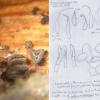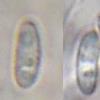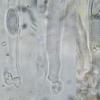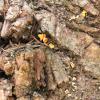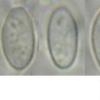
21-12-2025 09:32
Hello.A tiny ascomycete found embedded in wood in

21-12-2025 21:32
Pol DebaenstHello, Garden, Burgweg 19, Veurne, BelgiumOn 10/1

22-12-2025 23:38
Patrice TANCHAUDBonsoir, récolte sur un mur en pierre, apothéci

22-12-2025 00:47
Patrice TANCHAUDBonsoir, récolte à proximité du milieu dunaire

21-12-2025 21:40
Isabelle CharissouBonjour, j'aimerais connaitre les références de

20-12-2025 23:08
Patrice TANCHAUDBonsoir, récolte sur sol sablonneux dans l'arri�
Unguiculariopsis, again
David Malloch,
10-03-2009 16:53
 Collections of Unguiculariopsis reported on this forum have stimulated some discussion, but it is not clear from this how host-specific they are. I have recently collected one on Nemopanthus mucronatus (Ilicaceae) near my home in New Brunswick. In Zhuang's monograph it is most similar morphologically to U. adirondacensis. However, it is definitely not associated with discomycetes as U. adirondacensis should be. The only possible host for mine might be a very decayed layer of a corticioid fungus, perhaps a species of Peniophora. If I use host for my determination I get U. acerina, which has much longer excipular hairs. Are the collections of Unguiculariopsis species seen by members of this forum always associated with a host? Is it possible that host-specificity has been overemphasized?
Collections of Unguiculariopsis reported on this forum have stimulated some discussion, but it is not clear from this how host-specific they are. I have recently collected one on Nemopanthus mucronatus (Ilicaceae) near my home in New Brunswick. In Zhuang's monograph it is most similar morphologically to U. adirondacensis. However, it is definitely not associated with discomycetes as U. adirondacensis should be. The only possible host for mine might be a very decayed layer of a corticioid fungus, perhaps a species of Peniophora. If I use host for my determination I get U. acerina, which has much longer excipular hairs. Are the collections of Unguiculariopsis species seen by members of this forum always associated with a host? Is it possible that host-specificity has been overemphasized?
Hans-Otto Baral,
10-03-2009 17:30

Re:Unguiculariopsis, again
Dear David
I cannot precisely answer your question since I am so far not much able to develop a species concept in this genus, although I have studied perhaps 50 collections. It is only my impression that some species are remarkably host-specific, but I did not see enough collections to be more sure.
I am very sure, however, that a lot of existing species are not in Zhuang's monograph. As to your specimen, its characters seem quite normal, so identification will be difficult. Did you exmaine it rather shortly after collecting? (is 8.III.09 the collection date?) Usually the spores contain two conspicuous oil drops, sometimes also several smaller ones, and perhaps never none. If the find was made more than some months ago then you should see the oil drops very well as soon as you mount in KOH. They at least help in developing a species concept.
Zotto
I cannot precisely answer your question since I am so far not much able to develop a species concept in this genus, although I have studied perhaps 50 collections. It is only my impression that some species are remarkably host-specific, but I did not see enough collections to be more sure.
I am very sure, however, that a lot of existing species are not in Zhuang's monograph. As to your specimen, its characters seem quite normal, so identification will be difficult. Did you exmaine it rather shortly after collecting? (is 8.III.09 the collection date?) Usually the spores contain two conspicuous oil drops, sometimes also several smaller ones, and perhaps never none. If the find was made more than some months ago then you should see the oil drops very well as soon as you mount in KOH. They at least help in developing a species concept.
Zotto
Stip Helleman,
10-03-2009 18:56

Re:Unguiculariopsis, again
Dear David,
The host specifity of coarse can not be said from one collection as in this monograph but there is quite a difference between the hosts of the host, the host's host of adirondacensis is Abies balsamea, i think this has some effect in the host specifity.
Cheers Stip
The host specifity of coarse can not be said from one collection as in this monograph but there is quite a difference between the hosts of the host, the host's host of adirondacensis is Abies balsamea, i think this has some effect in the host specifity.
Cheers Stip
David Malloch,
10-03-2009 19:03

Re:Unguiculariopsis, again
Dear Zotto,
The collection was made last Sunday. Of course the apothecia were frozen quite hard, but my experience with such fungi is that they produce good spore prints when they are thawed out. I took a picture of some spores in 5% KOH. As you can see they have numerous small oil drops. Some spores still in the asci had two larger drops but this was not true of most of them.
Thanks for your help.
Dave
The collection was made last Sunday. Of course the apothecia were frozen quite hard, but my experience with such fungi is that they produce good spore prints when they are thawed out. I took a picture of some spores in 5% KOH. As you can see they have numerous small oil drops. Some spores still in the asci had two larger drops but this was not true of most of them.
Thanks for your help.
Dave
David Malloch,
10-03-2009 20:23

Re:Unguiculariopsis, again
Dear Stip,
After I sent off my post I thought of the host's host too. Of course you are right. A disco on balsam fir is quite different from a Peniophora on Nemopanthus. As Zotto said, this fungus will be hard to identify. After I read your post I went outside and found a big patch of Lachnellula agassizii (or is Lachnellula calyciformis the correct name?) on a dead balsam fir and brought it inside in hopes of finding U. adirondacensis. But the lachnellula is very healthy this time of year and Unguiculariopsis species seem to prefer dead or dying hosts. No luck.
Dave
After I sent off my post I thought of the host's host too. Of course you are right. A disco on balsam fir is quite different from a Peniophora on Nemopanthus. As Zotto said, this fungus will be hard to identify. After I read your post I went outside and found a big patch of Lachnellula agassizii (or is Lachnellula calyciformis the correct name?) on a dead balsam fir and brought it inside in hopes of finding U. adirondacensis. But the lachnellula is very healthy this time of year and Unguiculariopsis species seem to prefer dead or dying hosts. No luck.
Dave
Hans-Otto Baral,
10-03-2009 21:51

Re:Unguiculariopsis, again
Dear David
that's a good result! Many Unguiculariopsis are strictly biguttulate. Anyhow I cannot help at the moment, perhaps in 10 years :-)
Lachnellula agassizii is a good species. I saw this only very rarely and I never heard of European records. Could you please make a test: I found it to differ from L. calyciformis in having strongly hemiamyloid apical rings (IKI), while calyciformis is always inamyloid. Also the asci arise from croziers while calyciformis usually has none. For the hemiamyloid reaction you must use Lugol, not Melzer. See my paper on Lugol vs. Melzer my homepage:
http://www.gbif-mycology.de/HostedSites/Baral/
Zotto
that's a good result! Many Unguiculariopsis are strictly biguttulate. Anyhow I cannot help at the moment, perhaps in 10 years :-)
Lachnellula agassizii is a good species. I saw this only very rarely and I never heard of European records. Could you please make a test: I found it to differ from L. calyciformis in having strongly hemiamyloid apical rings (IKI), while calyciformis is always inamyloid. Also the asci arise from croziers while calyciformis usually has none. For the hemiamyloid reaction you must use Lugol, not Melzer. See my paper on Lugol vs. Melzer my homepage:
http://www.gbif-mycology.de/HostedSites/Baral/
Zotto
David Malloch,
11-03-2009 02:54

Re:Unguiculariopsis, again
Dear Zotto,
I mounted the asci of my Lachnella collection in Lugol's Solutions, in Melzers Solution, heated and unheated, and in Melzers with 5% KOH pretreatment. In none of these could I see any colour change in the ascus apex. There may have been a faint gray colour with Lugol's but this was hardly visible. On that basis my collection must be L. calyciformis. On the other hand, I believe the asci have croziers, which you suggest is a characteristic of L. agassizii.
Dave
I mounted the asci of my Lachnella collection in Lugol's Solutions, in Melzers Solution, heated and unheated, and in Melzers with 5% KOH pretreatment. In none of these could I see any colour change in the ascus apex. There may have been a faint gray colour with Lugol's but this was hardly visible. On that basis my collection must be L. calyciformis. On the other hand, I believe the asci have croziers, which you suggest is a characteristic of L. agassizii.
Dave
David Malloch,
11-03-2009 03:05
Hans-Otto Baral,
11-03-2009 09:18

Re:Unguiculariopsis, again
I found Lachnellula to survive drought and frost, at least for a shorter period of time. You must only take them indoor and spray water on them.
What I a now interested is a photo of the spores (and spore size), would you be so kind? We have actually also L. calyciformis with croziers here in Europe but on Pinus (mugo, strrobus), not on Abies and Picea which are the typical substrates of calyciformis.
Zotto
What I a now interested is a photo of the spores (and spore size), would you be so kind? We have actually also L. calyciformis with croziers here in Europe but on Pinus (mugo, strrobus), not on Abies and Picea which are the typical substrates of calyciformis.
Zotto
David Malloch,
11-03-2009 14:52

Re:Unguiculariopsis, again
Dear Zotto,
I measured and photographed the fresh spores in 5% KOH. I get 5.6-7.2 X 2.8-3.6 µm when measuring through the microscope (10 spores) which is slightly larger than the photo. This may only be because different spores were measured and the sample was small. Using a squash mount may give some immature spores so I have prepared some material for a spore shoot. I'll let you know if there is a difference.
Interestingly, the hymenium had some Cortinarius spores on it. This suggests that the apothecia were present in late October.
Dave
I measured and photographed the fresh spores in 5% KOH. I get 5.6-7.2 X 2.8-3.6 µm when measuring through the microscope (10 spores) which is slightly larger than the photo. This may only be because different spores were measured and the sample was small. Using a squash mount may give some immature spores so I have prepared some material for a spore shoot. I'll let you know if there is a difference.
Interestingly, the hymenium had some Cortinarius spores on it. This suggests that the apothecia were present in late October.
Dave
Hans-Otto Baral,
11-03-2009 22:59

Re:Unguiculariopsis, again
Hi Dave
that's a good observation with the Cortinarius! I believe the apos are persistent and survive some weeks in the dry state depending on the conditions.
Thanks for the spores, they look very much like calyciformis! but you must not use KOH in the case you have fresh (live) spores , you kill them and thereby they may shrink a bit. So please use tap water for mounting your spore print.
Zotto
that's a good observation with the Cortinarius! I believe the apos are persistent and survive some weeks in the dry state depending on the conditions.
Thanks for the spores, they look very much like calyciformis! but you must not use KOH in the case you have fresh (live) spores , you kill them and thereby they may shrink a bit. So please use tap water for mounting your spore print.
Zotto
